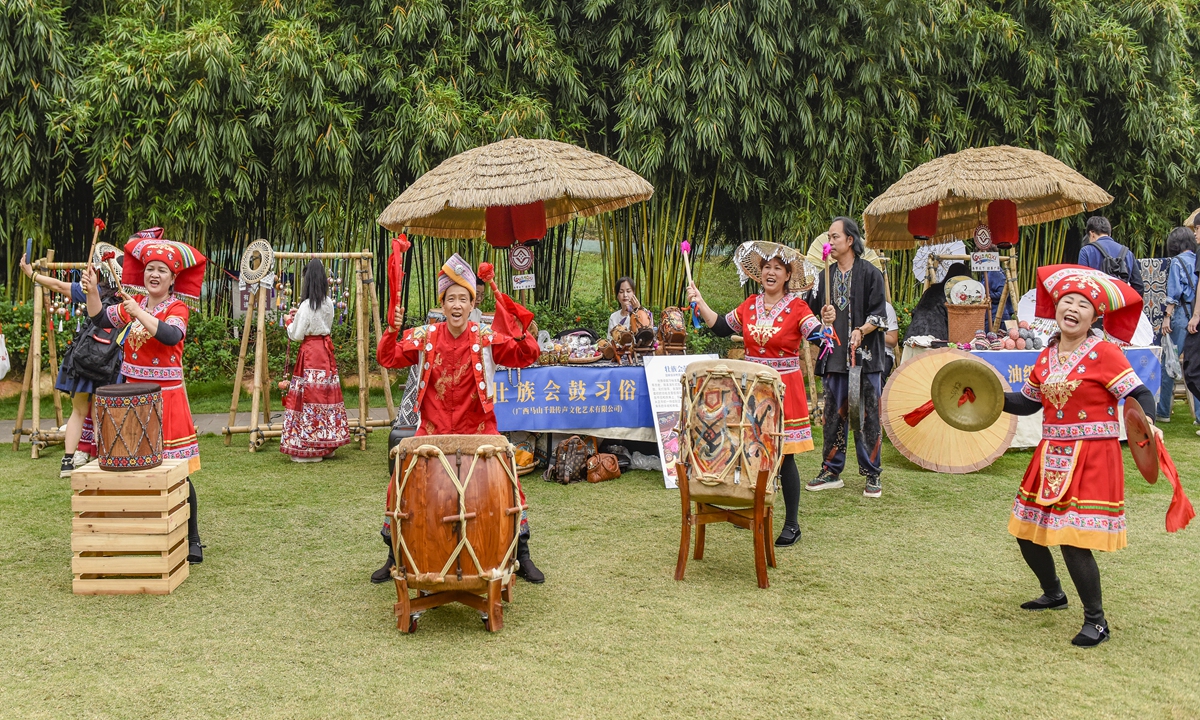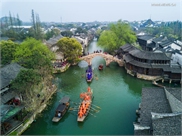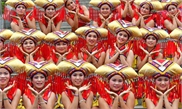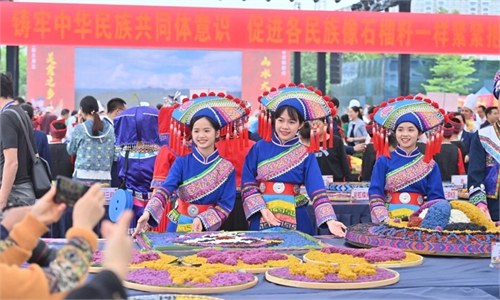ARTS / CULTURE & LEISURE
Experience Sanyuesan in Nanning
Unique traditions and identity of the Zhuang ethnic group

Zhuang people play the drums to celebrate the Sanyuesan Festival in Nanning, uangxi, on Thursday. Photos: VCG
The Zhuang People's Sanyuesan Festival, falling on the third day of March of the lunar calendar, also known as "Sam Nyied Sam" in the Zhuang language, is one of the most important traditional festivals celebrated by the Zhuang ethnic group, primarily in the Guangxi Zhuang Autonomous Region in South China. This is a time rich in cultural significance, festivity, and sense of community, showcasing the unique traditions and identity of the Zhuang people, China's largest minority group.
A series of cultural activities, such as folk song performances and displays of special intangible cultural heritage, was held in Nanning, the capital city of Guangxi. According to various domestic airlines, many visitors from Association of Southeast Asian Nations (ASEAN) members have secured their flight reservations to Guangxi for Sanyuesan Festival. Currently, the most popular route between Guangxi and ASEAN is the Nanning-Bangkok flight, reported BBRTV, a media outlet based in Guangxi.
Grand festival
The origins of Sanyuesan Festival are deeply rooted in the Zhuang people's history, mythology, and agricultural practices. While specific stories about the festival's beginnings vary, many relate to themes of love, heroism, and the veneration of nature and ancestors. One popular legend tells of a tragic love story that ended with the lovers turning into butterflies, symbolizing eternal love and the renewal of life.
This annual celebration is a time for the Zhuang people to honor their ancestors, celebrate their ethnic identity, and welcome the spring. It's also an opportunity to pray for good weather, a bountiful harvest, and the overall well-being for the community.
In recent years, the festival has also become a tourist attraction, with people from other parts of China and the world coming to experience Zhuang culture. The local government and cultural organizations often organize large-scale events, including cultural performances, traditional sports, and exhibitions of Zhuang handicrafts, to promote cultural heritage preservation and intercultural exchange.
Singing is a vital part of Zhuang culture, and song fairs are held where people engage in "Antiphonal Singing" (duet singing contests) to express love and friendship. These singing performances are not just musical contests but also social gatherings where young people can meet.
Even today, when you wander around in local parks in Nanning, you can hear many residents sing beautifully using portable karaoke sets.
When you visit Nanning for Sanyuesan, you will be able to see and maybe even experience the time-honored traditions passed down from generation to generation by the Zhuang people.
People participate in rituals to worship their ancestors and the gods of nature, often in sacred places such as ancient woods or atop mountains. The Lusheng, a traditional reed-pipe instrument, accompanies dances and celebrations, adding to the festival's vibrant atmosphere. Participants often wear traditional Zhuang clothing, featuring bright colors and intricate embroidery, symbolizing cultural pride and heritage.
Sanyuesan Festival is not just a testament to the enduring spirit and traditions of the Zhuang people but also an important reminder of the richness and diversity of China's ethnic cultures.
More surprises
Guangxi is the autonomous region with the largest population of ethnic minorities in China, which accounts for 37.6 percent of the region's total permanent population. The Chinese nation is closely united and all ethnic groups are members of the nation.
If you want to explore the rich and diverse ethnic cultures of China, there's no better place to visit than thethe Anthropology Museum of Guangxi located in Nanning.
The museum is a premier institution dedicated to the preservation, research, display, and promotion of the tangible and intangible heritage of the region's diverse ethnic communities. With a built-up space of 30,000 square meters, the museum stands as a witness to the rich cultural mosaic of Guangxi.
The museum's main building draws architectural inspiration from the iconic Guangxi bronze drum, symbolizing the region's rich geographical and ethnic heritage. Its design, resembling a roc spreading its wings, houses state-of-the-art facilities including a movie hall, multi-functional hall, heritage specimen observation room, specialized libraries, a virtual museum, and a room for social collections.
Visitors to the museum can immerse themselves in the Colorful Guangxi exhibition and the Culture of Bronze-drum exhibition, which highlight the unique local architecture, clothing, and wooden artifacts of Guangxi. These exhibitions offer valuable insights into the customs, origins, and evolution of the bronze-drum culture among Guangxi's ethnic minorities. The gorgeous garments exhibition presents the stunning attire of different ethnic groups, highlighting the vibrant charm of Guangxi's ethnic cultures and arts.
This museum not only serves as a cultural hub for learning about Guangxi's diverse ethnic groups but also plays a crucial role in promoting intercultural understanding and appreciation. Whether you're interested in traditional artifacts, ethnic arts, or the vibrant culture of Guangxi, the Guangxi Museum of Nationalities offers a rich and immersive experience.



